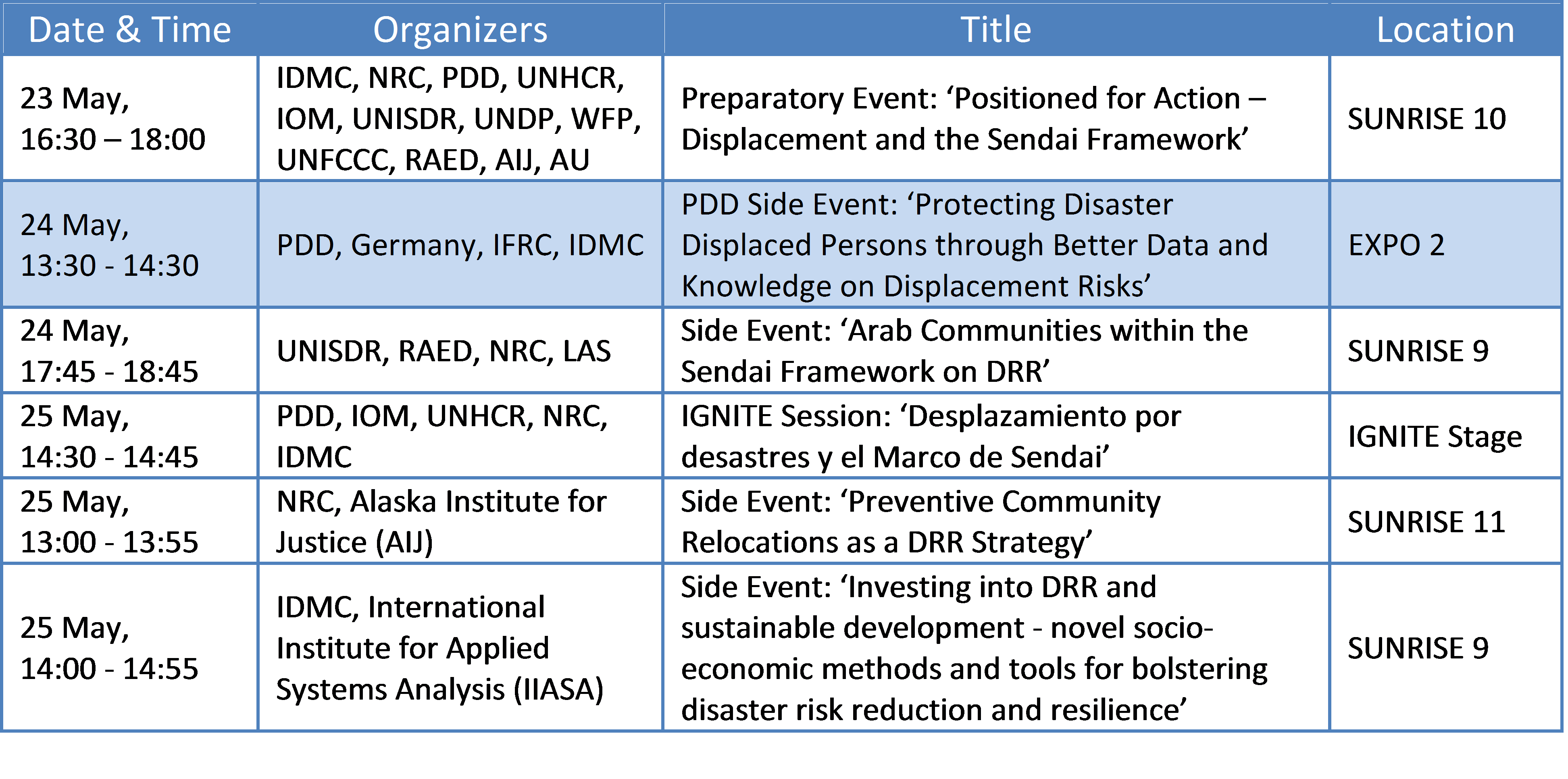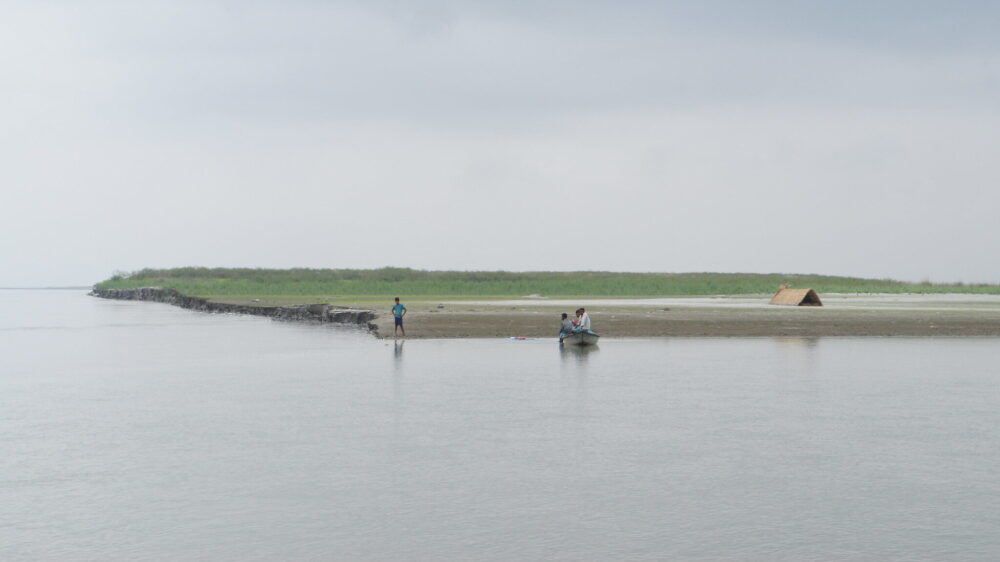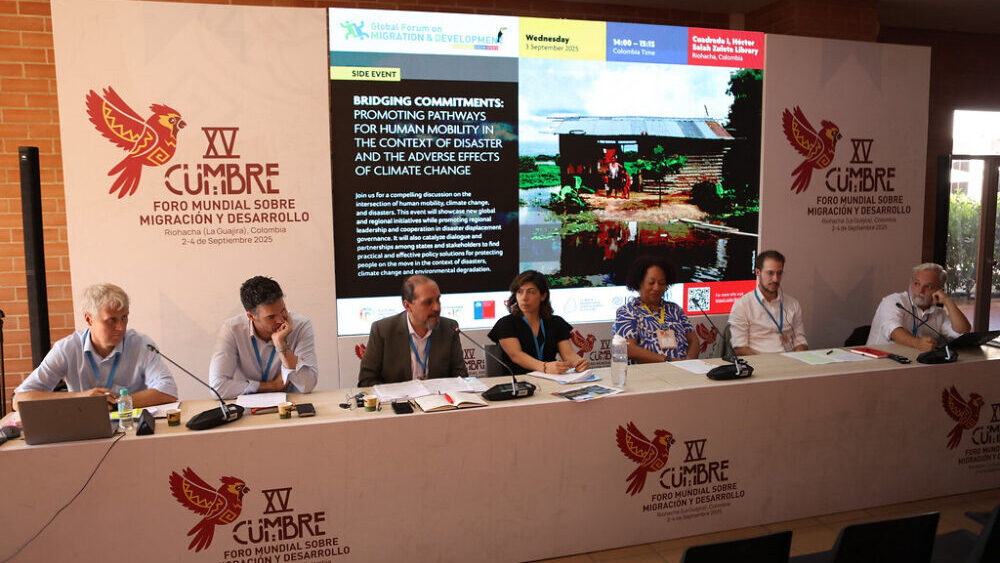Reporting back – the Platform on Disaster Displacement and the 2017 Global Platform for Disaster Risk Reduction in Cancun, Mexico

The Platform on Disaster Displacement (PDD) attended the 2017 Global Platform for Disaster Risk Reduction (GP17) on 22-26 May 2017 and organized a side event for addressing data and knowledge gaps.
The GP17 is the first time that governments and other disaster risk reduction (DRR) stakeholders have come together to take stock on the implementation of the Sendai Framework. The Framework recognises disaster displacement as an important concern for people-centred DRR and provides several opportunities for DRR policy and practice to reduce and address displacement in the context of disasters and climate change. Despite this, much needs to be done regarding the implementation of concrete provisions at the local, national and regional level in order to reduce displacement risks and address disaster displacement.
In the absence of a global target and indicator on displacement, the Platform on Disaster Displacement (PDD) promotes the inclusion of displacement in national DRR targets and indicators as a useful and important marker of progress of having people at the centre of the implementation of the Sendai Framework.
Key Messages for the 2017 Global Platform in Cancún
In preparing for the Global Platform, Member States and partners were encouraged to use their statements and interventions to promote several key messages on disaster displacement:
- In the implementation of the Sendai Framework, integrate disaster displacement and human mobility in local, national and regional DRR strategies.
- To successfully formulate and implement provisions on disaster displacement in DRR strategies and practice, strengthen all-of-society engagement and seek coordinated partnership of actors.
- Strengthen the systematic collection and monitoring of displacement data at local, national and regional levels and make it accessible as critical evidence for DRR policy and planning.
These messages were drafted at the request and in consultation with the PDD Steering Group and with contributions from PDD Advisory Committee members: International Organization for Migration (IOM), United Nations High Commissioner for Refugees (UNHCR), Norwegian Refugee Council (NRC), Internal Displacement Monitoring Centre (IDMC) and South American Network for Environmental Migrations (RESAMA). To see the detailed messages, please have a look at the PDD Policy Brief and Messages.
Stakeholder interventions
Stakeholders made good use of the PDD key messages. Displacement in the context of disasters and the need to prevent and prepare for disaster displacement was mentioned across different plenary, thematic and working sessions. For example, the need to have policy coherence on displacement dimensions of disasters was underscored in Plenary Four on “Coherence between the Sendai Framework, the 2030 Agenda for Sustainable Development and Climate Change”. Also, the need for coherence with the Global Compact on Safe, Orderly and Regular Migration and the Global Compact on Refugees was further emphasized.
Over 13 States and the EU, UN agencies and INGOs promoted the PDD key messages in their statements, notably, Germany, the Philippines, Switzerland, the EU, IDMC/ NRC, Caritas Internationalis, UNHCR and IOM.
UNHCR’s statement called upon the Global Platform on Disaster Risk Reduction to include in the Chairman’s summary, a meaningful recognition of the displacement dimension – the displacement reality – of disasters.
Overall, the statements reiterated that disasters are increasingly recognized as drivers of displacement and the number of persons displaced by disasters has markedly increased in recent years. The statements noted the need to integrate internal displacement and human mobility in national and regional DRR strategies, including specific provisions on preventing, preparing for and addressing disaster displacement in order to reduce displacement risks. The statements also noted the need for better data and evidence on new and ongoing disaster displacement to understand disaster displacement risk and to inform DRR strategies, implementation and reporting at national level, as well as to the Sendai Framework Monitor.
Events organized by PDD and partners
PDD organized a side event on ‘Protecting Disaster Displaced Persons through Better Data and Knowledge on Displacement Risks’ and there were other events on human mobility organized by partners.
 The IGNITE session, a joint presentation by IOM, NRC, Costa Rica and IDMC, highlighted different perspectives on how to include human mobility, migrants and displaced people into DRR efforts.
The IGNITE session, a joint presentation by IOM, NRC, Costa Rica and IDMC, highlighted different perspectives on how to include human mobility, migrants and displaced people into DRR efforts.
A Speed Networking organized by PDD and UNHCR on the last day of the Platform permitted participants to meet others working on similar issues in other regions and exchange contact details for potential future collaboration.
Outcome Documents and the Way Ahead
There are two outcome documents of the GP17: the Cancun High Level Communiqué and the Chair’s Summary.
The High Level Communiqué in its Paragraph 4 states: The loss becomes itself a driver of further vulnerability and exposure, and thus of disaster risk, weakens resilience and increases the likelihood of disaster displacement.
The Chair’s Summary states that: The development of disaster risk reduction strategies should consider regional and cross-border perspectives and include provisions that aim to prevent displacement attributed to disasters and reduce displacement risk, address the protection needs of displaced people and promote durable solutions to displacement (p.7).
The outcome documents are going to be brought to the attention of the High Level Political Forum, convening in New York from 10-19 July 2017.
Next steps
PDD together with Advisory Committee members (ISDR, IOM, UNHCR and NRC) is going to draft practical guidance on disaster displacement and DRR (“Words into Action”) to help states implement the Sendai Framework and their commitments.
Countries which would like advice on how to include displacement provisions in their DRR policies and strategies by 2020 (Target E) are invited to contact the Coordination Unit.
To see more of PDD’s work on DRR, also consult the workplan.
Useful Documents
PDD Policy Brief
 Loading...
Loading...
PDD Messages
 Loading...
Loading...
PDD Side Event Flyer
 Loading...
Loading...
PDD Side Event Concept Note
